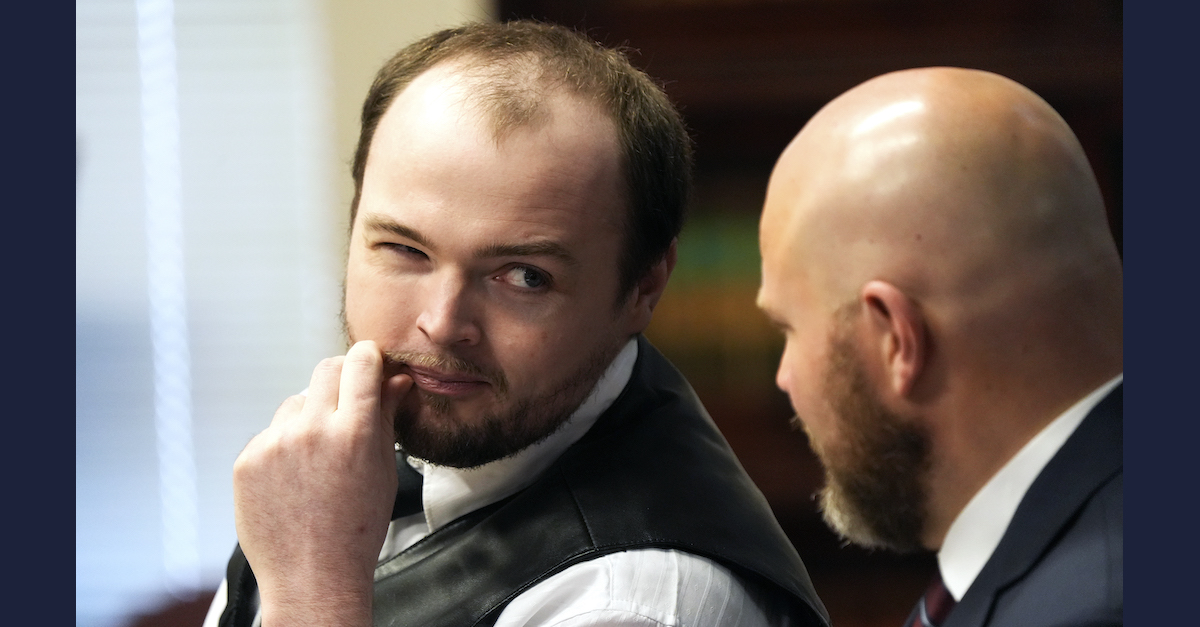
George Wagner IV chats with Defense Attorney John P. Parker. (Image via Brooke LeValley/The Columbus Dispatch/Pool.)
An Ohio appeals court judge has sided with journalists in a dispute over access to evidence photos in the trial of a man accused of playing a role in a mass murder.
George Wagner IV is one of several defendants charged in Ohio’s so-called “Pike County Massacre.”
Prosecutors have argued that Hanna May Rhoden was the main target of the violence in the late evening hours of April 21, 2016 and early morning hours of April 22, 2016. Eight members of the Rhoden and Gilley families were dead when it concluded.
Defendant Jake Wagner pleaded guilty to 23 charges in April 2021. He said his family conspired to murder the victims because they wanted sole custody of Sophia, the daughter Jake shared with Hanna May.
Judge Randy D. Deering issued an order on July 1, 2022, that arguably banned the press from recording “any exhibit” displayed in the case.
“[U]ntil all verdicts are rendered, and all trial proceedings have concluded, no media recording shall be made of any exhibit before or after such exhibit is admitted into evidence,” Deering’s original order said.
An additional order caused additional concerns. The appellate opinion explains:
In a second order made from the bench during the trial (“Supplemental Media Order”), Relators allege that Respondent prohibited the media from photographing, recording, or broadcasting any exhibits displaying blood, dead bodies, or minor victims. On September 16, 2022, prosecutors introduced images of bloody shoeprints and instructed the media to refrain from photographing the images while they were displayed on the monitor for the jury to view. The complaint alleges that on September 18, 2022, a reporter from the Cincinnati Enquirer requested access to photograph the shoeprint exhibits. The request was denied and the reporter was told to make the request in writing to the clerk of courts office once the evidence was admitted.
“With regard to the Supplemental Media Order and the request to photograph the shoeprint exhibits, the court did not conduct a hearing, make appropriate findings, or enter its decision on the record,” Administrative Judge Michael D. Hess wrote from the appellate bench. “It is unclear whether any hearing was conducted regarding the initial Media order, but the entry fails to make any findings.”

Suzanne Elliott, an Ohio Bureau of Criminal Investigations analyst who in 2016 was a trace evidence examiner, testifies in the trial of George Wagner IV on Tuesday Sept. 27, 2022 in Pike County Common Pleas Court in Waverly, Ohio. (Pool photos by Liz Dufour/Cincinnati Enquirer.)
With that criticism, the analysis continued.
The Cincinnati Enquirer sought a writ of prohibition — a ruling to block Judge Deering’s order.
“To warrant a writ of prohibition, the relator must establish the existence of three prerequisites: (1) the court or officer against whom the writ is sought is about to exercise judicial or quasi-judicial power, (2) the exercise of that power is clearly unauthorized by law, and (3) denial of the writ will cause injury for which there is no adequate remedy in the ordinary course of law,” appellate judge Hess wrote.
The Ohio Constitution contains a guarantee that “[a]ll courts shall be open,” and Ohio’s court rules require that the “judge assigned to the trial or hearing shall permit the broadcasting or recording by electronic means and the taking of photographs in court proceedings that are open to the public as provided by Ohio law,” Hess wrote (with emphasis added by him).
Without engaging in a concrete analysis on the merits, Hess wrote that the standard for a writ of prohibition had been met — largely because Deering failed to conduct a hearing to ascertain whether press access to the exhibits in question needed to be shut down.
“Should Judge Deering or the prosecutors wish to restrict the media’s recording access in the future, the trial court must hold a hearing and make findings on the record in accordance with the factors enumerated above,” Hess wrote. “The Supplemental Media Order and Paragraph 16 of the initial Media Order are hereby stricken and deemed unenforceable. Any pending motions are denied as moot.”
Appellate judges are generally disinclined to rule on merits issues without a factual record developed in the trial courts; this decision fits that general practice and pattern. However, the upshot was to grant the press access to the exhibits in question and a coupled warning about the general status of Ohio law as requiring open and transparent access to the courts.
A full copy of Hess’s order is available here.
Have a tip we should know? [email protected]